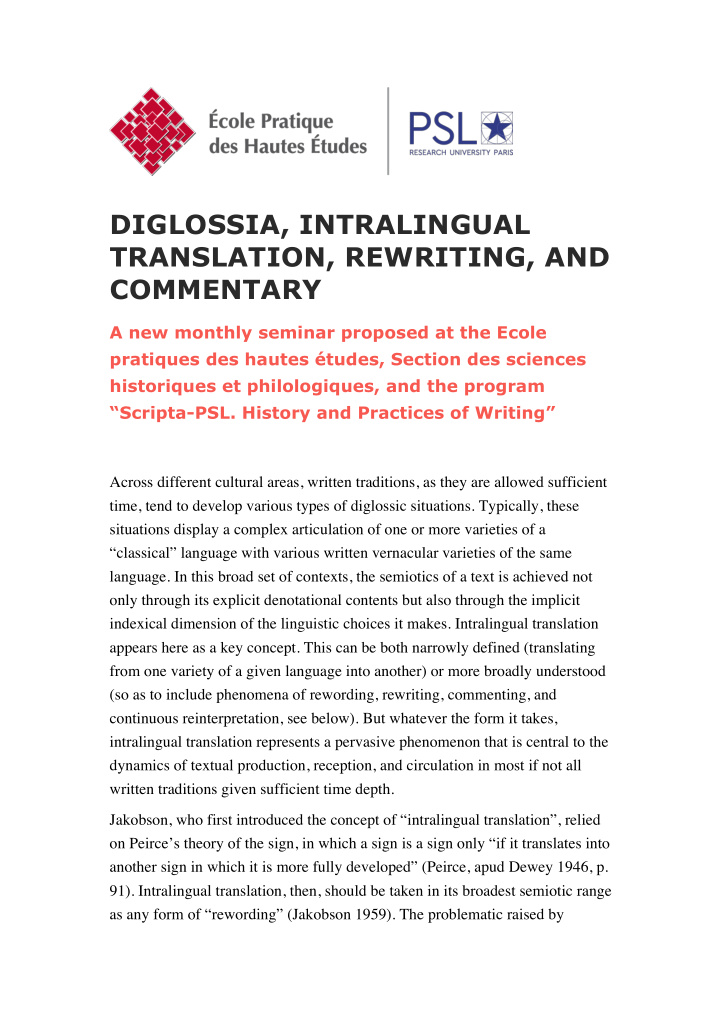



DIGLOSSIA, INTRALINGUAL TRANSLATION, REWRITING, AND COMMENTARY A new monthly seminar proposed at the Ecole pratiques des hautes études, Section des sciences historiques et philologiques, and the program “Scripta-PSL. History and Practices of Writing” Across different cultural areas, written traditions, as they are allowed sufficient time, tend to develop various types of diglossic situations. Typically, these situations display a complex articulation of one or more varieties of a “classical” language with various written vernacular varieties of the same language. In this broad set of contexts, the semiotics of a text is achieved not only through its explicit denotational contents but also through the implicit indexical dimension of the linguistic choices it makes. Intralingual translation appears here as a key concept. This can be both narrowly defined (translating from one variety of a given language into another) or more broadly understood (so as to include phenomena of rewording, rewriting, commenting, and continuous reinterpretation, see below). But whatever the form it takes, intralingual translation represents a pervasive phenomenon that is central to the dynamics of textual production, reception, and circulation in most if not all written traditions given sufficient time depth. Jakobson, who first introduced the concept of “intralingual translation”, relied on Peirce’s theory of the sign, in which a sign is a sign only “if it translates into another sign in which it is more fully developed” (Peirce, apud Dewey 1946, p. 91). Intralingual translation, then, should be taken in its broadest semiotic range as any form of “rewording” (Jakobson 1959). The problematic raised by
intralingual translation broadly understood further relates to the (Bakthinian) dialogic nature of language itself, whereby a (written) utterance always echoes, and reworks, a whole set of previous (written) utterances. It directly leads to central questions in the study of the production, reception, and circulation of texts. Practices of rewriting and commenting, stylistic and linguistic choices, and the dimensions of intertextuality, re-entextualization, and continued semiosis, are a few examples of the topics this concept potentially encompasses. While a convenient model contrasts a high (or “classical”) variety with “lower” (vernacular) ones, actual configurations and practices may be vastly more complex, and richer. Intralingual translation into a vernacular variety is not limited to serving instrumental purposes (rendering a classical, or ancient, text more “accessible”, in an expert-to-lay relationship): when construed as rewriting, it may also serve to enhance the Classics (as shown in numerous examples in premodern China). It may be a genuinely hermeneutic procedure (as probably in many places). The “classical language” itself may be a (political, ideological) construct, or it may be culturally construed as associated with pristine times in ritual contexts (as in ancient Egypt). Elements of the classical language and of vernaculars may further coexist within the same text. Carrying different indexical values, they contribute to enhance the overall potency of the language, and thus of the text in which such language is deployed. When multiple writing systems, or varieties of a writing system, are in simulatenous use, the problematic is additionally complexified on the graphic level. For example, the cross-culturally common practices of heterography— defined as writing a language (variety) with the written signs of another language (variety)—is central to scribal practices in many ancient written traditions. It can represent yet another facet of intralingual translation (including transcription), rewording, and continued interpretation. Intralingual translation is therefore proposed as a fundamental paradigm in language awareness in historical perspective, as embodied in textual practices. It leads to problematizing received categories such as the dichotomy between “classical” and “vernacular”, and to a blurring of the categories of translating, rewriting, and interpreting. It also implies engaging ideological issues at stake in language identification as well as in cultural reappropriations of the past. We 2
believe that introducing this concept in explicit terms can contribute significant new insights in the study of textual production, transmission, and interpretation in many cultural and historical environments, through taking full account of the linguistic dimension that is implied in these domains, with language being understood as a cultural practice. Our proposing the present seminar is based on the realization that the ancient written traditions studied at the EPHE and within Scripta afford an extraordinary wealth of materials for investigating the problematic of intralingual translation as outlined above. Such a seminar, held in our institution, can therefore be a forum for a rich and unique discussion across boundaries. Contributions by specialists in different cultural areas, both from our institutions and by a series of invited colleagues from abroad, should help outline an increasingly differentiated tableau of the variety of situations. Virtually any cultural and historical area is concerned, from Eastern Asia to the Indian worlds, ancient Persia, the ancient and medieval Near East including Egypt, the ancient Mediterranean worlds and medieval Europe … Contributions will be, and are invited, on all aspects of the problematic, from the more linguistic and semiotic ones to the more textual and cultural ones. Presentations may be more general in nature (sketching aspects of the problematic in a given cultural area) or focus on exemplary case studies, based on a more in-depth analysis of individual texts or groups of texts. Andréas Stauder & Rainier Lanselle, Ecole Pratique des Hautes Études, Section of Philological and Historical Sciences Barbara Bisetto, University of Milano-Bicocca 3
Recommend
More recommend